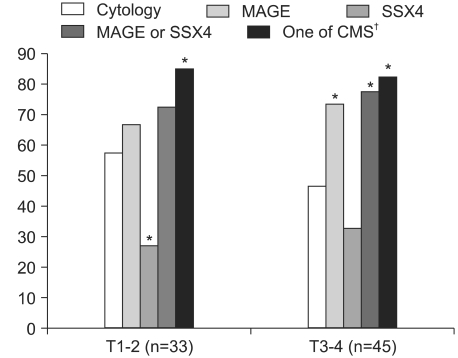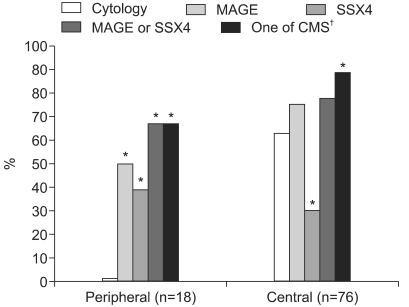Cancer Res Treat.
2007 Jun;39(2):69-73.
Detection of Lung Cancer using MAGE A1-6 and SSX4 RT-PCR Expression Profiles in the Bronchial Wash Fluid
- Affiliations
-
- 1Department of Internal Medicine, College of Medicine, Yeungnam University, Daegu, Korea.
- 2Department of Laboratory Medicine, College of Medicine, Yeungnam University, Daegu, Korea.
- 3Department of Thoracic and Cardiovascular Surgery, Seoul National University College of Medicine, Seoul, Korea.
- 4Department of Laboratory Medicine, College of Medicine, Catholic University of Daegu, Daegu, Korea. chjeon@cu.ac.kr
Abstract
-
PURPOSE: Bronchial wash fluid may be a useful for detecting lung cancer. To increase the detection rates, we performed molecular analysis with using MAGE A1-6 and SSX4 RT-PCR on bronchial wash fluid specimens.
MATERIALS AND METHODS
We obtained 57 lung cancer tissue specimens by bronchoscopic biopsy and 131 bronchial washes from 96 patients with lung cancer and 35 patients with benign lung diseases. The MAGE A1-6 and SSX4 gene expressions were investigated in the cancer tissue specimens and bronchial wash fluids. We evaluated the positive detection rates of these methods according to the cytology results and the clinical findings.
RESULTS
For the cancer tissue specimens and the bronchial wash fluid, the positive detection rate of MAGE or SSX4 was 91.2% and 75.0%, respectively. Combined MAGE and SSX4 PCR and cytology tests showed an 83.3% detection rate for the bronchial wash fluid. From bronchial washes of patients with benign lung diseases, the positive rates of using MAGE or SSX4 was 11.4%. In the bronchial wash fluid of lung cancer patients, 66.7% of the peripheral cancers were detected by MAGE or SSX4, while examination with cytology did not detect any peripheral lung cancer.
CONCLUSION
The application of both MAGE and SSX4 showed high sensitivity and specificity for the detection of lung cancer. Thus, MAGE and SSX4 RT-PCR may be effectively utilized as additional methods to improve detection of lung cancer with using bronchial wash fluids.
Keyword
MeSH Terms
Figure
Reference
-
1. Park JW, Kwon TK, Kim IH, Sohn SS, Kim YS, Kim CI, et al. A new strategy for the diagnosis of MAGE-expressing cancers. J Immunol Methods. 2002; 266:79–86. PMID: 12133624.
Article2. Plaen E, Arden K, Traversari C, Gaforio JJ, Szikora JP, De Smet C, et al. Structure, chromosomal localization, and expression of 12 genes of the MAGE family. Immunogenetics. 1994; 40:360–369. PMID: 7927540.
Article3. van der Bruggen P, Traversari C, Chomez P, Lurquin C, De Plaen E, van den Eynde B, et al. A gene encoding an antigen recognized by cytolytic T lymphocytes on a human melanoma. Science. 1991; 254:1643–1647. PMID: 1840703.
Article4. Jheon S, Hyun DS, Lee SC, Yoon GS, Jeon CH, Park JW, et al. Lung cancer detection by a RT-nested PCR using MAGE A1--6 common primers. Lung Cancer. 2004; 43:29–37. PMID: 14698534.
Article5. Bedrossian CW, Rybka DL. Bronchial brushing during fiberoptic bronchoscopy for the cytodiagnosis of lung cancer: comparison with sputum and bronchial washings. Acta Cytol. 1976; 20:446–453. PMID: 1068615.6. Halling KC, Rickman OB, Kipp BR, Harwood AR, Doerr CH, Jett JR. A comparison of cytology and fluorescence in situ hybridization for the detection of lung cancer in bronchoscopic specimens. Chest. 2006; 130:694–701. PMID: 16963665.
Article7. Chan EC, Lam SY, Tsang KW, Lam B, Ho JC, Fu KH, et al. Aberrant promoter methylation in Chinese patients with non-small cell lung cancer: patterns in primary tumors and potential diagnostic application in bronchoalevolar lavage. Clin Cancer Res. 2002; 8:3741–3746. PMID: 12473584.8. Mecklenburg I, Stratakis DF, Huber RM, Häussinger K, Morresi-Hauf A, Riethmüller G, et al. Detection of melanona antigen-A expression in sputum and bronchial lavage fluid of patients with lung cancer. Chest. 2004; 125:164S–166S. PMID: 15136490.9. Xinarianos G, Scott FM, Liloglou T, Prime W, Turnbull L, Walshaw M, et al. Evaluation of telomerase activity in bronchial lavage as a potential diagnostic marker for malignant lung disease. Lung Cancer. 2000; 28:37–42. PMID: 10704707.
Article10. Fielding P, Turnbull L, Prime W, Walshaw M, Field JK. Heterogeneous nuclear ribonucleoprotein A2/B1 up-regulation in bronchial lavage specimens: a clinical marker of early lung cancer detection. Clin Cancer Res. 1999; 5:4048–4052. PMID: 10632338.11. Gure AO, Wei IJ, Old LJ, Chen YT. The SSX gene family: characterization of 9 complete genes. Int J Cancer. 2002; 101:448–453. PMID: 12216073.12. Chi SN, Cheung NK, Cheung IY. Expression of SSX-2 and SSX-4 genes in neuroblastoma. Int J Biol Markers. 2002; 17:219–223. PMID: 12521124.
Article13. Mashino K, Sadanaga N, Tanaka F, Yamaguchi H, Nagashima H, Inoue H, et al. Expression of multiple cancer-testis antigen genes in gastrointestinal and breast carcinomas. Br J Cancer. 2001; 85:713–720. PMID: 11531257.
Article14. Tajima K, Obata Y, Tamaki H, Yoshida M, Chen YT, Scanlan MJ, et al. Expression of cancer/testis (CT) antigens in lung cancer. Lung Cancer. 2003; 42:23–33. PMID: 14512184.
Article15. Pasic A, Postmus PE, Sutedja TG. What is early lung cancer? A review of the literature. Lung Cancer. 2004; 45:267–277. PMID: 15301867.16. Paik HC, Lee DY, Lee HK, Kim SJ, Lee KB. Chest wall implantation of carcinoma after fine needle aspiration biopsy. Yonsei Med J. 1994; 35:349–354. PMID: 7975745.
Article17. Voravud N, Shin DM, Dekmezian RH, Dimery I, Lee JS, Hong WK. Implantation metastasis of carcinoma after percutaneous fine-needle aspiration biopsy. Chest. 1992; 102:313–315. PMID: 1623781.
Article18. Yahata N, Ohyashiki K, Ohyashiki JH, Iwama H, Hayashi S, Ando K, et al. Telomerase activity in lung cancer cells obtained from bronchial washings. J Natl Cancer Inst. 1998; 90:684–690. PMID: 9586665.
Article19. Jones AM, Hanson IM, Armstrong GR, O'Driscoll BR. Value and accuracy of cytology in addition to histology in the diagnosis of lung cancer at flexible bronchoscopy. Respir Med. 2001; 95:374–378. PMID: 11392578.
Article20. Hirsch FR, Franklin WA, Gazdar AF, Bunn PA. Early detection of lung cancer: clinical perspectives of recent advances in biology and radiology. Clin Cancer Res. 2001; 7:5–22. PMID: 11205917.21. Ahmed A, Ahmed S. Comparison of bronchoalveolar lavage cytology and transbronchial biopsy in the diagnosis of carcinoma of lung. J Ayub Med Coll Abbottabad. 2004; 16:29–33. PMID: 15762059.22. Sen S, Reddy VG, Guleria R, Jain SK, Kapila K, Singh N. Telomerase - a potential molecular marker of lung and cervical cancer. Clin Chem Lab Med. 2002; 40:994–1001. PMID: 12476937.
Article23. Fielding P, Turnbull L, Prime W, Walshaw M, Field JK. Heterogeneous nuclear ribonucleoprotein A2/B1 up-regulation in bronchial lavage specimens: a clinical marker of early lung cancer detection. Clin Cancer Res. 1999; 5:4048–4052. PMID: 10632338.
- Full Text Links
- Actions
-
Cited
- CITED
-
- Close
- Share
- Similar articles
-
- MAGE Gene Expression in Bronchial Washing Fluid in Suspected Parenchymal Lung Cancer
- The Clinical Implication of MAGE Gene Detection in Bronchial Washing Fluid in Routine Practice
- The Utility of MAGE Gene Detection in Bronchial Washing Fluid for Patients with Peripheral NSCLC
- Detection of Rare Cancer Cells in the Blood by RNA Extraction of Filtered Mononuclear Cells and Reverse Transcription-PCR
- The expression of melanoma antigen encoding gene in lung cancer




